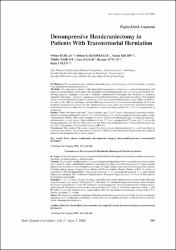| dc.contributor.author | Barlas, Orhan | |
| dc.contributor.author | Karadereler, Selhan | |
| dc.contributor.author | Krespi, Yakup | |
| dc.contributor.author | Yeşilot, Nilüfer | |
| dc.contributor.author | Bahar, Sara | |
| dc.contributor.author | Tuncay, Rezzan | |
| dc.contributor.author | Tolun, Reha | |
| dc.date.accessioned | 2016-07-25T11:11:03Z | |
| dc.date.available | 2016-07-25T11:11:03Z | |
| dc.date.issued | 2008 | |
| dc.identifier.citation | Barlas O, Karadereler S, Krespi Y, Yesilot N, Bahar S, Tuncay R, Tolun R. Decompressive hemicraniectomy in patients with transtentorial herniation. J Nervous Sys Surgery 2008; 1(3):161-168. | en_US |
| dc.identifier.issn | 1306-4126 | |
| dc.identifier.uri | http://sscdergisi.org/ | en_US |
| dc.identifier.uri | https://hdl.handle.net/11446/1044 | en_US |
| dc.description | İstanbul Bilim Üniversitesi, Tıp Fakültesi. | en_US |
| dc.description.abstract | Objective: To present the results, technique and indications of decompressive hemicraniectomy in patients with unilateral transtentorial herniation.
Methods: Ten consecutive patients with intracranial hypertension refractory to medical management and transtentorial herniation were treated with decompressive hemicraniectomy over a 3-year period with the following diagnoses: malignant infarction (3 patients), subarachnoid hemorrhage and vasospasm (2 patients), traumatic brain injury (3 patients), spontanous intracerebral hemorrhage, and venous thrombosis. Neurological status was assessed by the Glasgow Coma Scale (GCS) and by the modified Rankin Scale (mRS) on admission, and by the mRS on discharge, and on follow-up examinations. Computerized tomography (CT) scans performed preoperatively, and on the first, 7th postoperative days, and at one month were assessed for trastentorial herniation and midline shift. A decompressive hemicraniectomy, at least 14 by 11 cm was performed in all patients. | en_US |
| dc.description.abstract | Amaç: Unilateral transtentoryal herniasyonu olan hastalarda dekompresif hemikranyektominin sonuçlarını, tekniğini ve endikasyonlarını ortaya koymak.
Yöntem: Üç yıl içinde, medikal tedaviye dirençli intrakranyal hipertansiyonlu ve transtentoryal herniasyonda, habis infarct (3 olgu), subaraknoid kanama ve vazospazm (2 olgu), travmatik beyin hasarı (3 olgu), spontan intraserebral kanama ve venöz tromboz tanıları olan 10 ardışık hastaya dekompresif hemikranyektomi yapıldı. Nörolojik durum girişte Glasgow Koma Skalası (GKS) ve modifiye Rankin Skalası (mRS) ile, çıkışta ve kontrollerde mRS ile değerlendirldi. Operasyon öncesinde, 1. ve 7. postoperatif günlerde ve 1.ayda yapılan bilgisayarlı tomografi (BT) incelemeleri değerlendirildi. Hastaların hepsinde en az 14x11 cm’lik dekompresif hemikranyektomi yapıldı. | en_US |
| dc.language.iso | eng | en_US |
| dc.publisher | Logos Yayıncılık Tic. A.Ş | en_US |
| dc.rights | info:eu-repo/semantics/openAccess | en_US |
| dc.subject | brain edema | en_US |
| dc.subject | craniectomy | en_US |
| dc.subject | decompressive surgery | en_US |
| dc.subject | intracranial pressure | en_US |
| dc.subject | transtentorial herniation | en_US |
| dc.subject | beyin ödemi | en_US |
| dc.subject | kranyektomi | en_US |
| dc.subject | dekompresif cerrahi | en_US |
| dc.subject | intrakranyal basınç transtentoryal herniasyon | en_US |
| dc.title | Decompressive hemicraniectomy in patients with transtentorial herniation | en_US |
| dc.title.alternative | Transtentoryal herniasyondaki hastalarda dekompresif hemikranyektomi | en_US |
| dc.type | article | en_US |
| dc.relation.journal | Sinir Sistemi Cerrahisi Dergisi/ Journal of Nervous System Surgery | en_US |
| dc.department | DBÜ, Tıp Fakültesi | en_US |
| dc.identifier.issue | 3 | |
| dc.identifier.volume | 1 | |
| dc.identifier.startpage | 161 | |
| dc.identifier.endpage | 168 | |
| dc.contributor.authorID | TR167913 | en_US |
| dc.contributor.authorID | TR191077 | en_US |
| dc.contributor.authorID | TR126260 | en_US |
| dc.contributor.authorID | TR140963 | en_US |
| dc.relation.publicationcategory | Belirsiz | en_US |


















